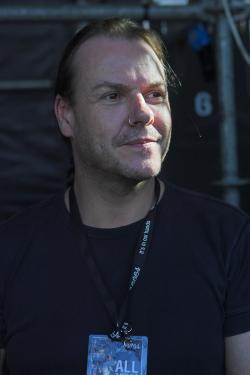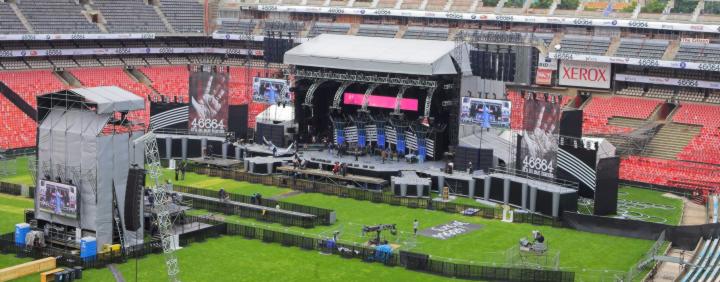| Pro-Light-News™ | Touring & Rigging |
| Main Index | Touring & Rigging | Forums & Search Site | PRO-MUSIC-NEWS |
Impressive technical design contributes to 46664 concert's impact
Gearhouse South Africa supplied design, full technical production and crew to the amazing 46664 Concert staged in Johannesburg’s Ellis Park stadium on World Aids Day. The landmark show featured an address by Nelson Mandela and a line up of leading local and international performers including Just Jinger, Freshly Ground, Johnny Clegg, Jamelia, Corrine Bailey Rae, Goo Goo Dolls, Razorlight, Live, Peter Gabriel and Annie Lennox. Live high-profile personal appearances also included Naomi Campbell. Imprinting the dramatic strap line “It’s In Our Hands” on people’s minds and aimed at raising AIDS awareness, 46664 Jo’burg was watched by 40,000 music fans in the stadium and broadcast live to millions of people around Africa and the world by the South African Broadcasting Company (SABC). The striking stage set, lighting and visuality of the event was designed by Gearhouse Director, Tim Dunn, who faced many challenges. A major one was ensuring that it looked equally as good on camera for the broadcast IMAG mix directed by the legendary Aubrey ‘Po’ Powell, as it did for the live audience. Another was building enough flexibility into the system to keep each act looking fresh and different, particularly for the after dark section, whilst also creating an eye-catching design that worked in daylight. Dunn wanted the aesthetics to be contemporary, distinctive in its own right and totally different from the inaugural concert in Cape Town in 2003 and the 2005 Concert in George. The striking stage set, lighting and visuality of the event was designed by Gearhouse Director, Tim Dunn, who faced many challenges. A major one was ensuring that it looked equally as good on camera for the broadcast IMAG mix directed by the legendary Aubrey ‘Po’ Powell, as it did for the live audience. Another was building enough flexibility into the system to keep each act looking fresh and different, particularly for the after dark section, whilst also creating an eye-catching design that worked in daylight. Dunn wanted the aesthetics to be contemporary, distinctive in its own right and totally different from the inaugural concert in Cape Town in 2003 and the 2005 Concert in George.In addition to the main 25 metre wide stage, there were also stage left and right ramps and long offstage wings to either side, all offering further performance areas. To ensure there was sufficient eye candy and depth for the cameras – particularly during the daylight section of the show, Dunn designed curved LED columns right at the heart of the 18 metre central stage revolve. The specially fabricated column frames were loaded with Optiscreen VP10 modules – five each side of the revolve – each measuring 4.80 metres high by 1.28 metre wide. Above these was a 12.20 metre wide by 1.52 metre deep strip of Lighthouse R16 LED, which was used for slogans and strap lines, and also blended in with the general screen content at specific times. Click the link t read more about Screens and LED Overhead, the main architectural elements of the lighting rig were six upstage/downstage trusses curving downwards at the downstage edge. Robe ColorWash 2500 moving lights were rigged onto the curved ends and utilised for the high level key lighting of performers – their position giving them access to hit any part of the stage. Eighteen Atomic strobes were positioned on the back end of these trusses, and In between these six curved-end trusses were another five straight trusses rigged at a higher trim and fully loaded with PARs. These were used for general stage wash coverage. Dunn used a combination of over 200 moving lights – a heterogenic mix of Robe, Martin and High End fixtures – scattered all over the rig, including some on the floor and others illuminating the complex set elements. Sixty-two i-Pix Satellite LED ‘bricks’ were utilised to tone the set and trusses, while the main onstage set pillars were illuminated with Martin Professional Mac 250 Wash fixtures and High End Studio Colour 575s. Twentyfour 8-lite blinders were rigged around the top perimeter of the set for blasting into the audience. At FOH, Dunn worked closely with lighting director Hugh Turner – the two are a regular double act – running three GrandMA consoles. One was purely controlling show lighting, one was used to run a host of digital media created and stored in two Grand MA digital media servers and the third was for audience and additional TV lighting plus back-up. The total fixture count topped 616, featuring over 4500 parameters between them and consuming 12 DMX universes. Dunn is the first person to acknowledge that it was a big team effort to get the visuals spot on. This equation also included Chris Grandin and Marcel Wijnberger from Gearhouse Media who created additional custom video content for the show, including the 46664 logo and strap-lines for the LED Screens. Pete Currier was Gearhouse’s daytime project manager for lighting and set. He co-ordinated between all the disciplines involved in the installation and set up, and ensured the correct interpretations took place between the creative/design elements and the logistics required to make it happen. This involved him working with up to 170 different people each day as the build gathered pace and intensity. Candice Scott took over as the night time project manager during each 24 hour shift. Interested in the sound setup? Here you go: 46664 sound setup Power supplyGearhouse Power’s Anthony Sackstein was responsible for installing enough generated electricity at Ellis Park to handle all the technical production’s requirements for the show, which was divided into 4 different areas and supplies. The first was a 1200 Amp 3-phase supply (4 x 300 KVAs) for generic lighting; the second was the stage right automation supply (2 x 300 KVAs) which dealt with all the moving lights on that side of stage plus anything with a ballast or running DMX, and this was mirrored by a similar supply on stage left. The fourth supply consisted of two 250 KVA sets for Audio, AV and LED screens. Each of these 4 supplies was synchronised to a back up generator as an additional precaution.Eighteen runs of approximately 100 metres of mains cable were run all around the venue, including 2 at 150 metres and one at 200 metres. Gearhouse Power had four techs on site including a wireman, 2 electricians and one power technician. It was one of the first outings where five of Gearhouse Power’s newest fully synchronisable, trailer-mounted Caterpillar generators were utilised. All Gearhouse Power machines are built and designed specifically for show purposes and for 46664, 5 additional machines were subhired from approved suppliers. Rigging and StagingGearhouse Rigging’s domain was overseen by Operations Manager Anthony Banks and head rigger Graham Brooking, working with a team of 6 on site riggers. They had 84 points of rigging in total between lighting, screens and PA, and used a selection of 1 and 2 tonne CM Lodestar hoists. The StageCo roof was loaded almost to capacity with 19 tonnes of lighting and screen in the main roof, most of it towards the front so that weight distribution along the roof trusses was a major challenge.Chris Loeijs co-ordinated the stage erection, based on a standard Stageco configuration with some special elements. He worked with four senior crew, four juniors and about 20 locals. Measuring 70 metres side to side, with 1200 square metres of decking and 250 tonnes of steel, the wings were a little higher than standard to carry the extra load, and it was five towers wide rather than the normal four to accommodate an additional 5 tonnes of lighting and screens on the main span. The 12.9 metres headroom offered plenty of scope for the lighting and stage set to look its fabulous best, with the whole construction standing at around 18 metres in height. The construction also included 120 square metres a side of backstage and offstage storage facilities, plus another 100 square metres at the back. Two ramps were built for backstage access, a steeper one on stage right for the load in and a gentler version on stage left for the get out. They also installed over 300 metres of crowd barrier and 120 square metres of rolling risers. The revolve was built by Lee Irving from Gearhouse In2Structures, a specialist set and structures building company. Measuring 18.3 metres in diameter and weighing 13 tonnes, it turned on two 5.5 Kw motors, optimised to perform the manoeuvre in a relaxed 68 seconds, although it could rotate the 180 degrees in as little as 10. In2Structures also manufactured and built various set pieces including the metal ‘trees’, the Optiscreen column cages and the huge printed scrims on the set and below the LED Screens either side of the stage. Jo’burg Set Company built the scenic columns along the front of the stage and the decking around the revolve. | |
 | |
ProductionGearhouse’s Ofer Lapid asked UK-based production manager Nick Levitt to take on the role of production director for the event. He worked with production managers Kenny Underwood (UK) and Micky Lehr (South Africa) and stage manager Nick Rea. Levitt has done lots of work with Gearhouse over the years and was also involved in the first 46664 in Cape Town, as well as having a vast experience of multi-act events. He brought in his technical manager (Nick Evans), engineer and CAD drawer to help oversee the engineering aspects of the build and the health & safety.Locally based Micky Lehr dealt with most of the site management and issues including dressing rooms, portacabins, site layout, accreditation, liaison with the stadium and the local authorities, police, and more. Levitt came on site two weeks beforehand. “It’s totally different to working in Europe or the US, and the pace and the resources are not the same, but it’s gone extremely smoothly, and it’s been great to work with Gearhouse” he comments, adding that it’s definitely been an advantage to be dealing with just the one company for all aspects of the technical production. Micky Lehr describes working at the Ellis Park site as similar to “Doing F1 in Monaco”, with real estate at a complete premium and everyone wanting a piece of the action. He was also the link between everything happening onstage and local promoters Real Concerts. One of the complications was that Ellis Park is still under construction as part of a major refurbishment, so in addition to his own staff of 100 plus, Lehr had to contend with hundreds of construction workers and their plant all over the place throughout the build process. It was also 6 years since the last gig there, and they only officially moved into site 2 weeks before the show – which was a very short lead time in which to produce a world class event. Security was exceptionally tight – considering the VIP list – but they had support from the City of Johannesburg, which paid for staging the event, and also from the Metro Police Services and the South African Police Services. On the day, they took the opportunity of a large event in the downtown location to implement some of the procedures being put in place for the 2010 World Cup in terms of crowd control or site egress. 46664 Johannesburg proved beyond a shadow of doubt that South Africa has the creative and technical production talent to stage world class events. |